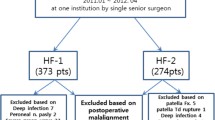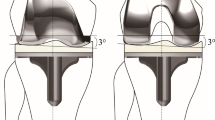Abstract
Purpose
A full range of motion after total knee arthroplasty has become more and more requested by our patients, leading to novel designs of knee implants, the so-called “hyperflex” knees. The aim of the present study was to confirm whether or not hyperflexion of operated knees really improves the patients’ quality of life.
Methods
A retrospective comparative case–control study has been carried out to compare clinical results shown in two types of knee prosthesis, from two homogeneous paired groups of patients including 45 cases of a “hyperflex” model (RP-F), while the control group consisted of 43 cases of a “regular design” model (Triathlon) in terms of expected postoperative flexion.
Results
The hyperflex group demonstrated significant higher mean values of passive flexion at 119.9° in the RP-F group versus 111.1° in the Triathlon group. However, global results in the “regular” control group were significantly better than the “hyperflex” study group, in both IKS knee and functional scores at 84.4 points (RP-F) vs. 89.8 points (Triathlon), and 84.6 points (RP-F) vs. 89.5 points (Triathlon), respectively. Moreover, the self-administered KOOS questionnaire was significantly in favor of the control group, with 73.5 points in RP-F knees versus 86.0 points for Triathlon knees at global KOOS postoperative scores.
Conclusion
The quality of life of operated patients after TKA obviously would be considered as the main priority, which was better obtained by a “regular design” in our study. Hence “high flexion” cannot be considered as an absolute target when choosing a model for total knee arthroplasty.




Similar content being viewed by others
References
Bellemans J, Banks S, Victor J, Vandenneucker H, Moemans A (2002) Fluoroscopic analysis of the kinematics of deep flexion in total knee arthroplasty. Influence of posterior condylar offset. J Bone Joint Surg (Br) 84:50–53
Bin SI, Nam TS (2007) Early results of high-flex total knee arthroplasty: comparison study at 1 year after surgery. Knee Surg Sports Traumatol Arthrosc 15:350–355
Charnley J (1972) The long-term results of low-friction arthroplasty of the hip performed as a primary intervention. J Bone Joint Surg (Br) 54:61–76
Cook LE, Klika AK, Szubski CR, Rosneck J, Molloy R, Barsoum WK (2012) Functional outcomes used to compare single radius and multiradius of curvature designs in total knee arthroplasty. J Knee Surg 25:249–253
Dennis DA, Komistek RD, Stiehl JB, Walker SA, Dennis KN (1998) Range of motion after total knee arthroplasty: the effect of implant design and weight-bearing conditions. J Arthroplasty 13:748–752
Devers BN, Conditt MA, Jamieson ML, Driscoll MD, Noble PC, Parsley BS (2011) Does greater knee flexion increase patient function and satisfaction after total knee arthroplasty? J Arthroplasty 26:178–186
Edwards JZ, Greene KA, Davis RS, Kovacik MW, Noe DA, Askew MJ (2004) Measuring flexion in knee arthroplasty patients. J Arthroplasty 19:369–372
Gandhi R, Tso P, Davey JR, Mahomed NN (2009) High-flexion implants in primary total knee arthroplasty: a meta-analysis. Knee 16:14–17
Gupta SK, Ranawat AS, Shah V, Zikria BA, Zikria JF, Ranawat CS (2006) The P.F.C. sigma RP-F TKA designed for improved performance: a matched-pair study. Orthopedics 29:S49–S52
Hall J, Copp SN, Adelson WS, D’Lima DD, Colwell CW Jr (2008) Extensor mechanism function in single-radius vs multiradius femoral components for total knee arthroplasty. J Arthroplasty 23:216–219
Harvey IA, Barry K, Kirby SP, Johnson R, Elloy MA (1993) Factors affecting the range of movement of total knee arthroplasty. J Bone Joint Surg (Br) 75:950–955
Huang H-T, Su JY, Wang G-J (2005) The early results of high-flex total knee arthroplasty: a minimum of 2 years of follow-up. J Arthroplasty 20:674–679
Insall JN, Dorr LD, Scott RD, Scott WN (1989) Rationale of the Knee Society clinical rating system. Clin Orthop Relat Res 248:13–14
Kurita M, Tomita T, Yamazaki T, Fujii M, Futai K, Shimizu N, Yoshikawa H, Sugamoto K (2012) In vivo kinematics of high-flex mobile-bearing total knee arthroplasty, with a new post-cam design, in deep knee bending motion. Int Orthop 36:2465–2471
Lamb SE, Frost H (2003) Recovery of mobility after knee arthroplasty: expected rates and influencing factors. J Arthroplasty 18:575–582
Laskin RS (2007) The effect of a high-flex implant on postoperative flexion after primary total knee arthroplasty. Orthopedics 30:86–88
Lizaur A, Marco L, Cebrian R (1997) Preoperative factors influencing the range of movement after total knee arthroplasty for severe osteoarthritis. J Bone Joint Surg (Br) 79:626–629
Massin P, Dupuy F-R, Khlifi H, Fornasieri C, De Polignac T, Schifrine P, Fareng C, Mertl P (2010) Does hyperflex total knee design improve postoperative active flexion? Orthop Traumatol Surg Res 96:376–380
Matsuzaki T, Matsumoto T, Muratsu H, Kubo S, Matsushita T, Kawakami Y, Ishida K, Oka S, Kuroda R, Kurosaka M (2013) Kinematic factors affecting postoperative knee flexion after cruciate-retaining total knee arthroplasty. Int Orthop 37:803–808
Meneghini RM, Pierson JL, Bagsby D, Ziemba-Davis M, Berend ME, Ritter MA (2007) Is there a functional benefit to obtaining high flexion after total knee arthroplasty? J Arthroplasty 22:43–46
Ornetti P, Parratte S, Gossec L, Tavernier C, Argenson J-N, Roos EM (2008) Cross-cultural adaptation and validation of the French version of the Knee Injury and Osteoarthritis Outcome Score (KOOS) in knee osteoarthritis patients. Osteoarthr Cartil 16:423–428
Ranawat AS, Gupta SK, Ranawat CS (2006) The P.F.C. sigma RP-F total knee arthroplasty: designed for improved performance. Orthopedics 29:S28–S29
Ritter MA, Harty LD, Davis KE, Meding JB, Berend ME (2003) Predicting range of motion after total knee arthroplasty. Clustering, log-linear regression, and regression tree analysis. J Bone Joint Surg Am 85-A:1278–1285
Roos EM, Roos HP, Lohmander LS, Ekdahl C, Beynnon BD (1998) Knee Injury and Osteoarthritis Outcome Score (KOOS), development of a self-administered outcome measure. J Orthop Sports Phys Ther 28:88–96
Von Elm E, Altman DG, Egger M, Pocock SJ, Gøtzsche PC, Vandenbroucke JP for the STROBE Initiative (2008) The strengthening the reporting of observational studies in epidemiology (STROBE) statement: guidelines for reporting observational studies. Internist (Berl) 49(6):688–693
Weeden SH, Schmidt R (2007) A randomized, prospective study of primary total knee components designed for increased flexion. J Arthroplasty 22:349–352
Author information
Authors and Affiliations
Corresponding author
Rights and permissions
About this article
Cite this article
Mencière, M.L., Epinette, JA., Gabrion, A. et al. Does high flexion after total knee replacement really improve our patients’ quality of life at a short-term follow-up?. International Orthopaedics (SICOT) 38, 2079–2086 (2014). https://doi.org/10.1007/s00264-014-2372-4
Received:
Accepted:
Published:
Issue Date:
DOI: https://doi.org/10.1007/s00264-014-2372-4




